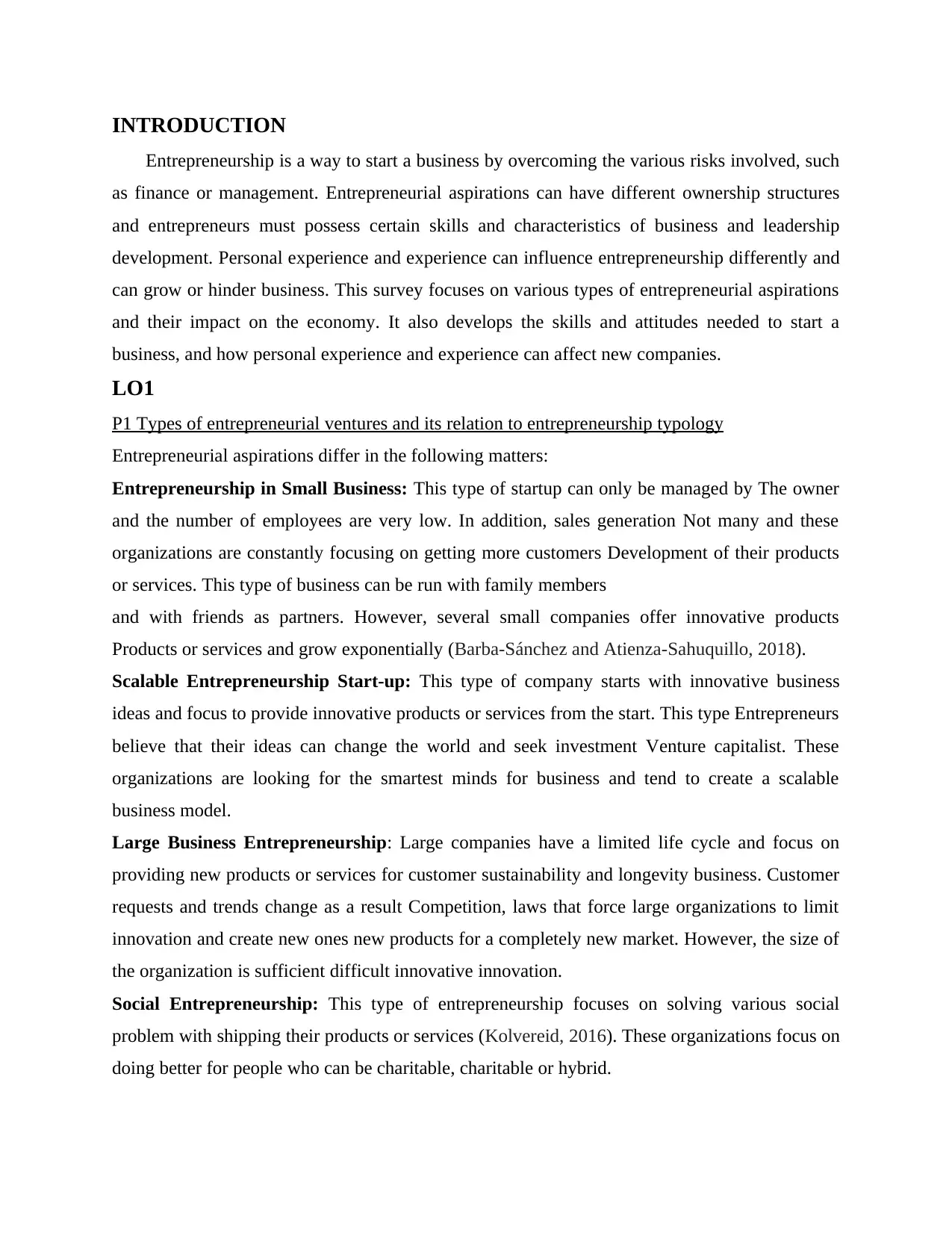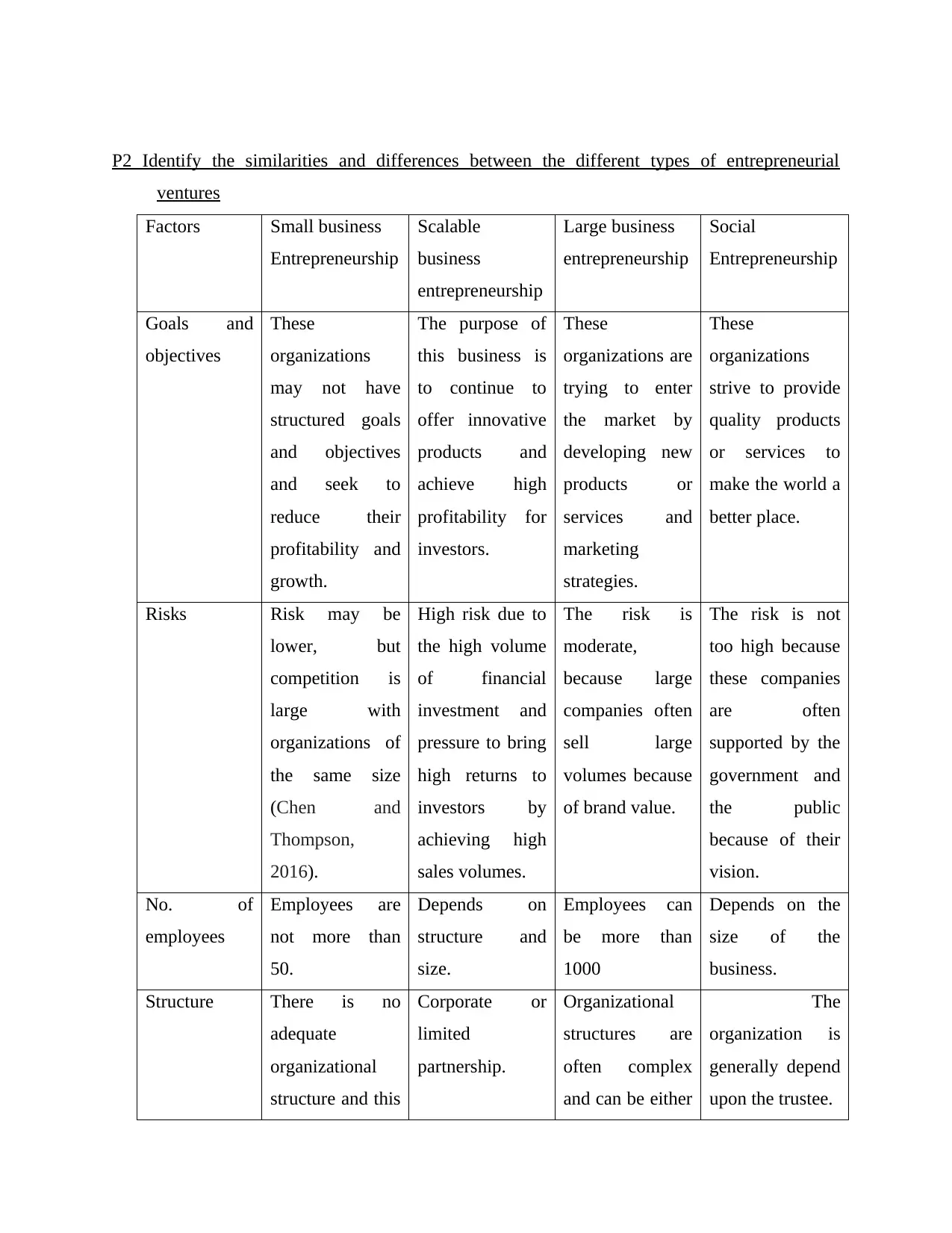Entrepreneurial Ventures: Types, Similarities, Differences & Typology
VerifiedAdded on 2021/02/22
|6
|1408
|53
Report
AI Summary
This report provides an overview of various types of entrepreneurial ventures, including small business entrepreneurship, scalable start-ups, large business entrepreneurship, and social entrepreneurship. It identifies the similarities and differences between these ventures, focusing on goals, risks, number of employees, and organizational structure. The report further explores the diversity of entrepreneurial aspirations in both the public and corporate sectors, highlighting the focus on social welfare in public organizations versus profit-driven strategies in corporate entities. It concludes by emphasizing the importance of skills and attitudes required for entrepreneurs to establish and manage businesses effectively, considering different risks involved. The document includes references to support its analysis and is available on Desklib, a platform that provides study tools and resources for students.

Entrepreneurship and small
business management
business management
Paraphrase This Document
Need a fresh take? Get an instant paraphrase of this document with our AI Paraphraser

.
Table of Contents
INTRODUCTION...........................................................................................................................3
LO1..................................................................................................................................................3
P1 Types of entrepreneurial ventures and its relation to entrepreneurship typology..................3
P2 Identify the similarities and differences between the different types of entrepreneurial
ventures........................................................................................................................................4
M1 Discover the diversity of entrepreneurial aspirations to show an understanding of
entrepreneurship in the public sector and companies......................................................................5
LO3..................................................................................................................................................5
LO4..................................................................................................................................................5
CONCLUSION................................................................................................................................6
REFERENCES................................................................................................................................7
Table of Contents
INTRODUCTION...........................................................................................................................3
LO1..................................................................................................................................................3
P1 Types of entrepreneurial ventures and its relation to entrepreneurship typology..................3
P2 Identify the similarities and differences between the different types of entrepreneurial
ventures........................................................................................................................................4
M1 Discover the diversity of entrepreneurial aspirations to show an understanding of
entrepreneurship in the public sector and companies......................................................................5
LO3..................................................................................................................................................5
LO4..................................................................................................................................................5
CONCLUSION................................................................................................................................6
REFERENCES................................................................................................................................7

INTRODUCTION
Entrepreneurship is a way to start a business by overcoming the various risks involved, such
as finance or management. Entrepreneurial aspirations can have different ownership structures
and entrepreneurs must possess certain skills and characteristics of business and leadership
development. Personal experience and experience can influence entrepreneurship differently and
can grow or hinder business. This survey focuses on various types of entrepreneurial aspirations
and their impact on the economy. It also develops the skills and attitudes needed to start a
business, and how personal experience and experience can affect new companies.
LO1
P1 Types of entrepreneurial ventures and its relation to entrepreneurship typology
Entrepreneurial aspirations differ in the following matters:
Entrepreneurship in Small Business: This type of startup can only be managed by The owner
and the number of employees are very low. In addition, sales generation Not many and these
organizations are constantly focusing on getting more customers Development of their products
or services. This type of business can be run with family members
and with friends as partners. However, several small companies offer innovative products
Products or services and grow exponentially (Barba-Sánchez and Atienza-Sahuquillo, 2018).
Scalable Entrepreneurship Start-up: This type of company starts with innovative business
ideas and focus to provide innovative products or services from the start. This type Entrepreneurs
believe that their ideas can change the world and seek investment Venture capitalist. These
organizations are looking for the smartest minds for business and tend to create a scalable
business model.
Large Business Entrepreneurship: Large companies have a limited life cycle and focus on
providing new products or services for customer sustainability and longevity business. Customer
requests and trends change as a result Competition, laws that force large organizations to limit
innovation and create new ones new products for a completely new market. However, the size of
the organization is sufficient difficult innovative innovation.
Social Entrepreneurship: This type of entrepreneurship focuses on solving various social
problem with shipping their products or services (Kolvereid, 2016). These organizations focus on
doing better for people who can be charitable, charitable or hybrid.
Entrepreneurship is a way to start a business by overcoming the various risks involved, such
as finance or management. Entrepreneurial aspirations can have different ownership structures
and entrepreneurs must possess certain skills and characteristics of business and leadership
development. Personal experience and experience can influence entrepreneurship differently and
can grow or hinder business. This survey focuses on various types of entrepreneurial aspirations
and their impact on the economy. It also develops the skills and attitudes needed to start a
business, and how personal experience and experience can affect new companies.
LO1
P1 Types of entrepreneurial ventures and its relation to entrepreneurship typology
Entrepreneurial aspirations differ in the following matters:
Entrepreneurship in Small Business: This type of startup can only be managed by The owner
and the number of employees are very low. In addition, sales generation Not many and these
organizations are constantly focusing on getting more customers Development of their products
or services. This type of business can be run with family members
and with friends as partners. However, several small companies offer innovative products
Products or services and grow exponentially (Barba-Sánchez and Atienza-Sahuquillo, 2018).
Scalable Entrepreneurship Start-up: This type of company starts with innovative business
ideas and focus to provide innovative products or services from the start. This type Entrepreneurs
believe that their ideas can change the world and seek investment Venture capitalist. These
organizations are looking for the smartest minds for business and tend to create a scalable
business model.
Large Business Entrepreneurship: Large companies have a limited life cycle and focus on
providing new products or services for customer sustainability and longevity business. Customer
requests and trends change as a result Competition, laws that force large organizations to limit
innovation and create new ones new products for a completely new market. However, the size of
the organization is sufficient difficult innovative innovation.
Social Entrepreneurship: This type of entrepreneurship focuses on solving various social
problem with shipping their products or services (Kolvereid, 2016). These organizations focus on
doing better for people who can be charitable, charitable or hybrid.
⊘ This is a preview!⊘
Do you want full access?
Subscribe today to unlock all pages.

Trusted by 1+ million students worldwide

P2 Identify the similarities and differences between the different types of entrepreneurial
ventures
Factors Small business
Entrepreneurship
Scalable
business
entrepreneurship
Large business
entrepreneurship
Social
Entrepreneurship
Goals and
objectives
These
organizations
may not have
structured goals
and objectives
and seek to
reduce their
profitability and
growth.
The purpose of
this business is
to continue to
offer innovative
products and
achieve high
profitability for
investors.
These
organizations are
trying to enter
the market by
developing new
products or
services and
marketing
strategies.
These
organizations
strive to provide
quality products
or services to
make the world a
better place.
Risks Risk may be
lower, but
competition is
large with
organizations of
the same size
(Chen and
Thompson,
2016).
High risk due to
the high volume
of financial
investment and
pressure to bring
high returns to
investors by
achieving high
sales volumes.
The risk is
moderate,
because large
companies often
sell large
volumes because
of brand value.
The risk is not
too high because
these companies
are often
supported by the
government and
the public
because of their
vision.
No. of
employees
Employees are
not more than
50.
Depends on
structure and
size.
Employees can
be more than
1000
Depends on the
size of the
business.
Structure There is no
adequate
organizational
structure and this
Corporate or
limited
partnership.
Organizational
structures are
often complex
and can be either
The
organization is
generally depend
upon the trustee.
ventures
Factors Small business
Entrepreneurship
Scalable
business
entrepreneurship
Large business
entrepreneurship
Social
Entrepreneurship
Goals and
objectives
These
organizations
may not have
structured goals
and objectives
and seek to
reduce their
profitability and
growth.
The purpose of
this business is
to continue to
offer innovative
products and
achieve high
profitability for
investors.
These
organizations are
trying to enter
the market by
developing new
products or
services and
marketing
strategies.
These
organizations
strive to provide
quality products
or services to
make the world a
better place.
Risks Risk may be
lower, but
competition is
large with
organizations of
the same size
(Chen and
Thompson,
2016).
High risk due to
the high volume
of financial
investment and
pressure to bring
high returns to
investors by
achieving high
sales volumes.
The risk is
moderate,
because large
companies often
sell large
volumes because
of brand value.
The risk is not
too high because
these companies
are often
supported by the
government and
the public
because of their
vision.
No. of
employees
Employees are
not more than
50.
Depends on
structure and
size.
Employees can
be more than
1000
Depends on the
size of the
business.
Structure There is no
adequate
organizational
structure and this
Corporate or
limited
partnership.
Organizational
structures are
often complex
and can be either
The
organization is
generally depend
upon the trustee.
Paraphrase This Document
Need a fresh take? Get an instant paraphrase of this document with our AI Paraphraser

often partners
with retailers.
limited public
companies or
private limited
companies
M1 Discover the diversity of entrepreneurial aspirations to show an understanding of
entrepreneurship in the public sector and companies.
In the public sector: Public organizations are controlled directly or indirectly by the
government. Governments invest more money in these organizations, and various private
organizations provide strategic assistance to these organizations. These organizations have
established themselves in various sectors and are trying to provide quality products or services to
their customers. These organizations do not focus on profitability, but on social welfare and
development.
In the corporate sector: These types of organizations work privately and may belong to
individuals or the public. These organizations develop marketing strategies to provide quality
products or services to their customers, increase their profits and longevity for the organization
(Krajňáková Navikaitė and Navickas, 2015). Companies that are very large, scalable business
ventures related to corporate sectors that focus on sustainable development by focusing on their
competitors and developing strategies to gain competitive advantage
LO3
Enclosed in PPT
LO4
Enclosed in PPT
CONCLUSION
Starter companies can consist of various types, such as: Small, small, medium and large
companies. Small businesses capture most of each industry and make a major contribution to the
with retailers.
limited public
companies or
private limited
companies
M1 Discover the diversity of entrepreneurial aspirations to show an understanding of
entrepreneurship in the public sector and companies.
In the public sector: Public organizations are controlled directly or indirectly by the
government. Governments invest more money in these organizations, and various private
organizations provide strategic assistance to these organizations. These organizations have
established themselves in various sectors and are trying to provide quality products or services to
their customers. These organizations do not focus on profitability, but on social welfare and
development.
In the corporate sector: These types of organizations work privately and may belong to
individuals or the public. These organizations develop marketing strategies to provide quality
products or services to their customers, increase their profits and longevity for the organization
(Krajňáková Navikaitė and Navickas, 2015). Companies that are very large, scalable business
ventures related to corporate sectors that focus on sustainable development by focusing on their
competitors and developing strategies to gain competitive advantage
LO3
Enclosed in PPT
LO4
Enclosed in PPT
CONCLUSION
Starter companies can consist of various types, such as: Small, small, medium and large
companies. Small businesses capture most of each industry and make a major contribution to the

economy of a country. Employers need to have certain skills and attitudes to establish and run a
business taking into account of different risks.
business taking into account of different risks.
⊘ This is a preview!⊘
Do you want full access?
Subscribe today to unlock all pages.

Trusted by 1+ million students worldwide
1 out of 6
Related Documents
Your All-in-One AI-Powered Toolkit for Academic Success.
+13062052269
info@desklib.com
Available 24*7 on WhatsApp / Email
![[object Object]](/_next/static/media/star-bottom.7253800d.svg)
Unlock your academic potential
Copyright © 2020–2025 A2Z Services. All Rights Reserved. Developed and managed by ZUCOL.


